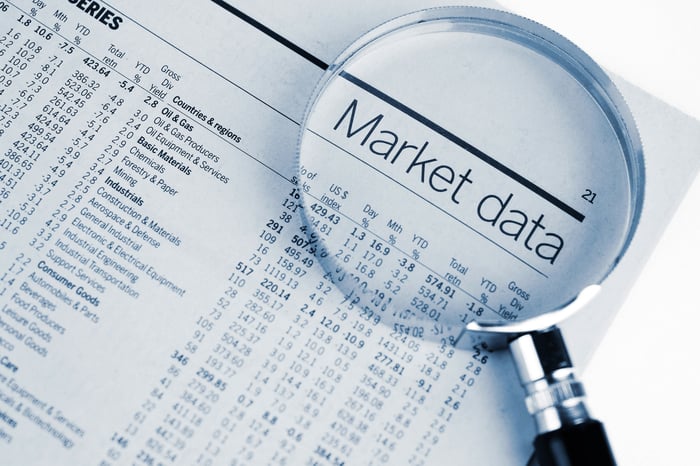The United States is widely regarded as the world's economic superpower. The health of the U.S. economy and stock market are considered paramount to the ongoing success of developed and emerging markets around the globe.
Given the United States' preeminent status on the financial stage, a lot of attention has been paid to the landmark credit downgrade issued by Fitch Ratings on Aug. 1, 2023.
Although Standard & Poor's (S&P), a division of the more-familiar S&P Global (SPGI 0.07%), downgraded the U.S. credit rating to AA+ from AAA in 2011, it's Fitch Ratings following suit roughly two weeks ago with a downgrade of its own to AA+ from AAA that's raising eyebrows on Wall Street.

Image source: Getty Images.
According to Fitch, multiple drivers factored into its rerating. This includes the government's growing debt burden, the expectation of weaker economic growth, if not a recession, over the coming three years, the negative impact of higher interest rates, and ongoing red tape on Capitol Hill that's led to multiple debt-ceiling standoffs.
But in spite of this debt downgrade, Fitch's AA+ rating outlook for the U.S. is stable, and it, ultimately, still represents the second-highest credit rating possible. U.S. government debt remains decisively in investment-grade territory, meaning there's an extremely high likelihood that the federal government will be able to service and eventually repay its outstanding debts.
These two companies offer a higher credit rating than the U.S. government
While U.S. government debt is often perceived to be one of the safest places to put your money to work, S&P has two publicly traded companies rated even higher than the U.S. government.
Back in 1980, more than 60 publicly traded companies carried the highly coveted AAA credit rating from S&P. By 2008, this figure had been reduced by 90% due to an assortment of economic challenges, industry shifts, innovation, competition, and acquisitions. Today, just two publicly traded companies have been bestowed with the AAA credit rating by Standard &Poor's.
Johnson & Johnson
The first well-known company with the highest credit rating possible from Standard & Poor's is healthcare stock Johnson & Johnson (JNJ -0.46%), which is commonly known as "J&J."
As some readers might be aware, J&J is facing as many as 100,000 lawsuits tied to its now-discontinued talcum-based baby powder. In April, the company offered $8.9 billion, without admitting guilt, to settle these collective suits, but had its strategy dismissed in court.
While a multibillion-dollar legal overhang would be a huge cause for concern for most businesses, it's not a game changer for Johnson & Johnson. No matter what financial culpability it may have (if any), the company's ability to service and repay its debts is highly unlikely to be affected by these talc-based lawsuits.
One macro factor working in J&J's favor is that the healthcare sector is highly defensive. As much as we'd like the liberty of choosing when we become ill and what ailment(s) we develop, this isn't a choice we have. Since people continue to need prescription drugs, medical technologies, and healthcare services, in any economic environment, it means Johnson & Johnson's operating cash flow tends to be consistent from one year to the next.
Another reason Johnson & Johnson likely finds itself as a AAA-rated company is its leadership. Since its founding in 1886, J&J has had only eight CEOs, including current CEO Joaquin Duato. With little turnover in key leadership positions, it means important strategic initiatives are being properly implemented. Not surprisingly, Johnson & Johnson delivered more than three decades of uninterrupted adjusted operating earnings growth that was only derailed by the COVID-19 pandemic.
Johnson & Johnson's revenue mix is an additional source of income and cash-flow stability. For over a decade, the company has been shifting more of its net sales to brand-name pharmaceuticals, which offer beefier margins and faster growth rates. To counter any possibility of future patent cliffs, the company has aggressively reinvested in novel research and numerous collaborative drug-development partnerships.
Johnson & Johnson closed out the first-half of 2023 with $28.5 billion in combined cash, cash equivalents, and marketable securities, has generated more than $19 billion in operating cash flow over the trailing-12-month period, and has increased its base annual payout in each of the past 61 years. In short, there's absolutely no concern that it can honor its financial obligations while continuing to grow its dividend.

Image source: Getty Images.
Microsoft
The only other publicly traded company with a higher credit rating than the U.S. government is tech giant Microsoft (MSFT 1.82%).
Unlike the healthcare sector, tech companies are cyclical. This means they tend to ebb and flow with the health of the U.S. economy. Despite Microsoft having to contend with potential order slowdowns during economic downturns, S&P has had no trouble maintaining its AAA credit rating on Microsoft for decades.
What makes Microsoft so special is its mix of next-generation cloud operations with its legacy businesses. As for the latter, Microsoft still generates a boatload of cash flow from legacy segments like Windows. Despite the company's Windows OEM segment not growing much, if at all, on a currency-neutral basis, around three-quarters of global desktops are still powered by the Windows operating system. That's a competitive advantage Microsoft is unlikely to give up anytime soon.
Couple this steady stream of revenue from the company's legacy brands with its rapidly growing assortment of cloud services, including Azure. Microsoft's Azure is the world's No. 2 cloud infrastructure service provider by market share, and it generated 27% currency-neutral sales growth in the June-ended quarter. In addition to Azure, Dynamics, Office Commercial, and the company's server products and cloud services segments are all delivering sustained double-digit, currency-neutral sales growth.
Similar to Johnson & Johnson, leadership is a big reason Microsoft is such a success. In the 48 years since its founding, Microsoft has had just three CEOs: Bill Gates (1975-2000), Steve Ballmer (2000-2014), and Satya Nadella (2014-current). Consistency at the top leads to predictable operating results, which Wall Street and credit-rating agencies appreciate.
Microsoft's massive cash pile is the final puzzle piece that explains why it's unlikely to lose its AAA credit rating. As of the end of June, Microsoft had more than $111 billion in cash, cash equivalents, and short-term investments, compared to a little over $47 billion in long-term debt. That's around $64 billion in net cash for a company that generated $87.6 billion in operating cash flow over the trailing 12 months.





